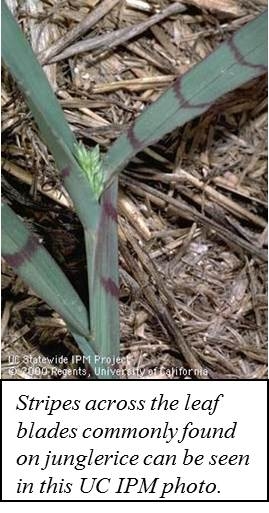From the May 2014 Tulare County UC Cooperative Extension "Field Crop Notes" newsletter
http://cetulare.ucanr.edu/newletters_898819/Field_Crop_Notes_692/?newsitem=51665
Managing Junglerice in Corn
by Steve Wright and Carol Frate
Introduction. The summer annual grass weed junglerice (Echinocloa colona) has become a difficult problem to control in corn fields in the southern San Joaquin Valley, especially minimum till fields, as well in other crops. Glyphosate products do not easily kill this weed unless the grass is quite small. Seed continues to germinate throughout the summer so even if junglerice seedlings are killed by a post-emergent herbicide, new seedlings can emerge the next day or next irrigation.
Junglerice identification. Seedling leaves are grayish or dull green in color. Often leaves are banded with purplish-red stripes across the blade but this feature can be absent. Mature plants are prostrate or erect and 2-3 ft tall. Leaves are rolled in the stem before emerging. Leaf blades are flat and usually the upper surface is hairless. Stems are hairless except at the nodes. There are no ligules or auricles. Purple banding on the leaves is the easy way to distinguish junglerice from barnyardgrass. There are more photographs and details on identification at the UC IPM website: http://www.ipm.ucanr.edu/PMG/WEEDS/junglerice.html.
A major concern is the development of glyphosate (Roundup) resistance in junglerice in California. Rotating glyphosate-resistant corn with other glyphosate-resistant crops such as cotton or alfalfa will only increase this problem. To help prevent the development of herbicide-resistant weeds and prevent weed shifts from occurring, it is important to incorporate tillage into your weed management practices, as well as alternating or tank-mixing herbicides that have different chemical modes of action.
Research Results. Research conducted in the SJV in 2011- 2013 by S. Wright and C. Frate with Matrix (rimsulfuron) and Laudis (tembotrione) demonstrated excellent junglerice control could be achieved when these materials are applied according to the labels. Both herbicides will enhance control of broadleaves, grasses, and glyphosate-resistant weeds, while also reducing glyphosate induced weed shifts. Matrix can be applied either preemergent to the corn and junglerice or postemergent to the corn. In the first case, corn is planted dry, the herbicide is applied and then followed by an irrigation to germinate the corn and activate the herbicide. The other approach is to preirrigate, plant or strip till and then plant. After weeds emerge treat postemergent to corn and junglerice. The most consistent results have been observed with a tank mix of glyphosate and Matrix. Matrix can be applied postemergent up to 12 inch corn but weeds must be small. “Steadfast”, a combination of Accent plus Matrix, applied postemergent has also demonstrated effective on control of young junglerice.
Laudis (tembotrione) also adds to the options available for corn growers to control junglerice. Laudis is for postemergence use. Best results are obtained when it is applied to young actively growing weeds. According to the label, Laudis can affect weeds that are larger than the recommended height; however applications of Laudis when weeds are taller than 4 to 5 inches in height may result in incomplete weed control activity. Broadcast applications of Laudis may be made to corn from emergence up to the V8 stage of growth. A second post-emergence application is allowable on corn but it must be a minimum of 14 days from the first application. According to the label, cultivation can help remove suppressed weeds or multiple flushing weeds. However, don't cultivate within 7 days of an application of Laudis as this could decrease the effectiveness of weed control due to disruption of herbicide translocation in the plant.